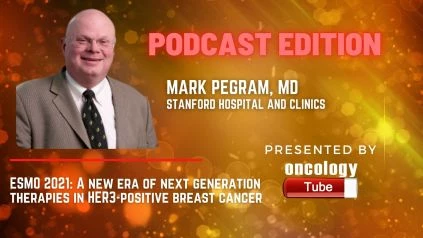Mark Pegram, MD the Susy Yuan-Huey Hung Professor, Medicine – Oncology, Stanford Hospital, and Clinics speaks about ESMO 2021 Abstract LBA1 – Trastuzumab deruxtecan (T-DXd) vs trastuzumab emtansine (T-DM1) in patients (Pts) with HER2+ metastatic breast cancer (mBC): Results of the randomized phase III DESTINY-Breast03 study (Enhertu).
LBA1 Abstract –
Background:
Based on the outcomes of DESTINY-Breast01, T-DXd is a HER2-targeting antibody–drug conjugate that has been authorized for patients with advanced HER2+ mBC (NCT03248492). DESTINY-Breast03 (NCT03529110) is a multicenter, open-label, randomized phase 3 trial evaluating the effectiveness and safety of T-DXd against T-DM1 in patients with HER2+ mBC who had previously had trastuzumab and taxane treatment. This is the first randomized study of T-DXd in British Columbia.
Methods:
The points were distributed in a 1:1 ratio. By blinded independent central review, the main outcome was progression-free survival (PFS) (BICR). Overall survival (OS), objective response rate (ORR), duration of response, PFS by investigator, and safety are secondary goals.
Results:
524 points had been randomized as of May 21, 2021. The average age was 54 years old (range, 20-83). PFS had a hazard ratio of 0.2840 (P = 7.8 x 10-22); median PFS for T-DXd was not attained vs. 6.8 mo for T-DM1. T-DXd had an estimated 12-month OS event rate of 94.1 percent (95 percent CI, 90.3-96.4) and T-DM1 had an estimated 12-month OS event rate of 85.9 percent (95 percent CI, 80.9-89.7); HR: 0.5546 (95 percent CI, 0.3587-0.8576; P = 0.007172 did not exceed pre-specified significance limit). T-DXd had a median treatment length of 14.3 months (range: 0.7-29.8) vs. T-DM1 had a median treatment duration of 6.9 months (range: 0.7-25.1), with identical incidence of TEAEs. There were no drug-related fatalities in either arm. Drug-related interstitial lung disease (ILD) was diagnosed in 10.5 percent of T-DXd patients (majority [9.7%] grade 1/2; 0 grade 4/5) vs 1.9 percent of T-DM1 patients (all grade 1/2).
Conclusions:
In patients previously treated with trastuzumab and taxane for HER2+ mBC, T-DXd showed a statistically significant and clinically relevant increase in PFS compared to T-DM1. These findings show that T-DXd is tolerated, with manageable toxicity and a significantly improved ILD profile as compared to trials in severely pretreated patients. This research will lead to a change in the way HER2+ mBC is treated.
Clinical trial identification
NCT03529110.

